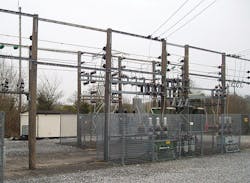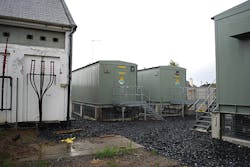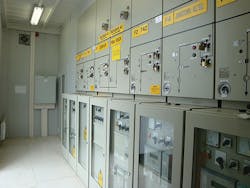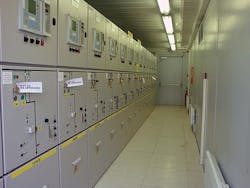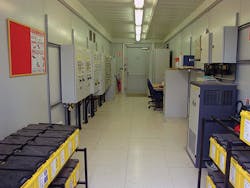ESB Accelerates Network Reinforcement
The existing 38-kV distribution system in Ireland — established in the early part of the 20th century and operated by ESB Networks — has changed from being the first widespread electrical network in the country to a distribution system now supplied by a 110-kV transmission system. The 38-kV and medium-voltage networks remained passive systems, being load driven with no dramatic changes, until the late 1990s. During this latter period, a significant amount of embedded generation was connected to the 38-kV and medium-voltage systems, placing an additional burden on the substation plant that effectively had reached the end of its life cycle.
To meet this challenging situation, ESB Networks developed an innovative solution in 2005 to accelerate the replacement of 38-kV distribution substations. Using compact modules containing gas-insulated switchgear (GIS) and control and protection equipment, 38-kV substations were upgraded to increase the capacity and reliability of the distribution network. This modular solution addressed the greatest challenges to the upgrade project, namely the high cost of land during the Irish economic boom years as most substations were in urban locations where additional land purchase or relocation of the substation was expensive. It also minimized the need for circuit diversions and outages on the 38-kV and medium-voltage networks, thus reducing the capital cost of construction as well as the time taken on project construction and commissioning.
Main Technical Challenges
The move from traditional air-insulated switchgear (AIS) installed in distribution substations to modular substations required standardizing many different features of the substation equipment, in particular, the type of switchgear. The withdrawable-type switchgear installed in many indoor medium-voltage substations in the past required the circuit breaker to be withdrawn on a separate mobile truck for maintenance, effectively increasing the space needed in front of the switchgear.
Therefore, non-withdrawable-type medium-voltage GIS was selected for the proposed modular substations. The standard 38-kV GIS, traditionally installed in conventional buildings, was adapted for modular application (that is, bus-bar-connected voltage transformers were used in lieu of feeder-connected voltage transformers, which in turn reduced the footprint of the GIS installation).
One of the major concerns about using modular equipment was the transportation of equipment, so maintaining tight dimensions was a key consideration. Hence, the nonwithdrawable-type GIS allowed the modules to be designed and constructed with the minimum dimensions technically acceptable for safe working clearances and operational purposes. The 38-kV and medium-voltage GIS used by ESB Networks is arc-proof tested internally per the International Electrotechnical Commission standards; additional safety features are incorporated in the module design, including arc shields, arc ducts and baffles, and overpressure relief vents.
Module Corrosion Protection
The humid, salty atmosphere can be severe in parts of Ireland and can have a considerable effect on nongalvanized ferrous parts as well as on aluminum and its alloys. Therefore, ESB Networks paid particular attention to the specification and assessment of coating systems used on substation modules.
Pregalvanized steel panels were used on the walls and roof, and the module was painted to a very high specification, which was selected following the accelerated aging tests specified in the International Organization for Standards by an independent laboratory.
Handling Modules
The handling of the larger-sized new modules introduced challenges not previously encountered in existing substation construction. In particular, the off-loading and installation of the modules required special attention because of the limited space to maneuver the modules in the majority of substations scheduled for refitting. The heaviest module weighed 24 tonnes (26 tons) and lifting required a 250-tonne (275-ton) crane.
Another major concern was the off-loading of modules in areas with live in-service equipment without encroaching on proximity safety distances. In many instances, circuits had to be switched out and, in some cases, it was necessary to drop conductors to allow the module to be placed in position. Where the local load demand could not be back-fed from the network or multiple outages could not be obtained, an alternative method had to be employed.
In these situations, the jack-and-skid method of installation was used to avoid encroaching on the limits of close proximity to live equipment and consequential outages. This involved using a track assembled on-site to slide the modules from the transport onto the foundation pads. Although this installation procedure took considerably longer than using a crane, it had the benefit of maintaining network supplies during installation.
Control and Protection Equipment
The purpose of these modular substations was not only to replace aging switchgear in a quick and convenient manner, but also to replace the control and protection systems that had reached the end of their life cycle, as well. In addition, this project included uprating the existing 24-Vdc battery system to a 220-Vdc system. Traditionally, the 24-Vdc system consisted of an indoor wall-mounted charger with miniature circuit breakers installed and an outdoor enclosure used to house the lead-acid battery. For environmental and safety reasons, ESB Networks selected a valve-regulated lead-acid battery, as it could be placed safely in the control room module and would require less maintenance.
Standardized protection schemes for the substation’s incoming and outgoing circuits were used in the design of the modular substations. To expedite the construction and delivery of equipment, a standard impedance (distance) protection relay was chosen for the 38-kV overhead lines, and a standard overcurrent and differential relay was chosen for the transformer bays. For the medium-voltage lines and transformer in-comers, a multifunction relay was chosen that could be programmed with all the necessary protection functions. These functions were then set according to the network voltage (10 kV or 20 kV) and the various system earthing methods used on the network (for example, isolated neutral or resistive grounding).
A major technical development was the change from the traditional remote terminal unit (RTU) control method, which was the norm in 38-kV distribution substations. During the initial modular substation trials, the station control system used the RTU method, which meant all the control signals and alarm signals were hardwired back to the control room module. These signals were brought to the station mimic panel and alarm annunciator panel, respectively. This traditional method did not offer any time or cost saving in terms of the installation and wiring work required on-site.
An investigation was conducted to determine the benefits of a substation control system (SCS) using fiber-optic control and signal equipment. The SCS had obvious benefits in that there was no longer a mimic control panel and an alarm annunciator panel. Also, as this system ran solely off 220 Vdc, it eliminated the use of a 24-Vdc battery in the substation. This created more space in the control room module and reduced the hardwiring required to connect the 38-kV and medium-voltage GIS equipment. Following the construction of several RTU-type modular substations, ESB Networks decided to standardize the use of SCS-type control equipment for all new installations.
Typical Substation Upgrade
A typical 38-kV substation upgrade in ESB Networks’ program comprised of replacing existing 38-kV and 10-kV outdoor or indoor AIS with GIS as well as replacing the existing transformers, usually 2-MVA or 5-MVA transformers. The new 38-kV and medium-voltage (10-kV or 20-kV) GIS are installed and factory acceptance tested on the module manufacturer’s premises before being shipped to Ireland. The empty module for the control and protection cabinets are fitted by the term contract cabinet manufacturer in Ireland. The cabinets are installed in the module, and the inter-panel cabling is completed prior to factory acceptance testing, and then the fully equipped control module is ready for delivery to the site.
Delivery of the control and protection module is coordinated to coincide with arrival of the 38-kV and medium-voltage modules from overseas. The entire process from the arrival of the modules on-site to final installation takes approximately four hours. The new high-voltage/low-voltage transformers, typically two 10-MVA units, are lifted into place during this process, making optimum use of the crane. It is estimated the off-site work has reduced the on-site time by a minimum of 280 man-hours. It also is possible to keep the existing AIS components in operation until the final changeover, thereby reducing outage time. Once the new modular substation is energized, the old AIS substation is decommissioned and removed.
The traditional method for replacing a 70-year-old substation, located on a confined site in a built-up urban location, would have been to build a new substation on an alternative site. The estimated benefits of replacing a 70-year-old substation on an existing site compared with the traditional approach are as follows:
• Reduction in construction time of 20 weeks (12 weeks on civil works and eight weeks on electrical work)
• Estimated savings per site of 500,000 euros (US$540,000), which takes into account no need to purchase a new substation site and diverting/extending the existing 38-kV and medium-voltage circuits.
Expected Life Cycle and Management
The introduction of modular substations and modern protection relays moves the distribution network from a passive system to a dynamic system, thus increasing the flexibility of the network. GIS components used in the modular substations have the added benefit of being relatively maintenance-free. This means a significant reduction in routine maintenance requirements compared with the original AIS equipment, as all the equipment is indoors and, thus, not subject to weathering effects or the pollution buildup that would require regular or routine on-site inspection checks by the utility’s personnel.
Evolving Changes in Load Patterns
As part of the Irish government’s national strategy to reduce electricity consumption generated from fossil fuels, the number of renewable energy generation projects has increased, namely wind and other forms of sustainable energy production connected to the distribution network. These changes plus the increase in domestic and commercial growth have all had a major impact on the country’s load patterns. The introduction of modular substations has helped to manage the evolving nature of the distribution network while allowing for future expansion and changes to network configurations. This has been done by adding a level of flexibility into the modular substation design, such as the protection schemes that enable nondirectional and directional protection of circuits. Load-driven demands also have been catered to by the introduction of dual-ratio instrument transformers on all bays that can be changed should load an increase in load occur.
There also is scope to install larger-capacity power transformers without the need to revise the protection requirements or the physical connections, such as the 38-kV and medium-voltage cabling to the transformer. The final consideration was the allowance of spare capacity on the 38-kV bus bar and medium-voltage bus bar, which is provided as standard in the modular substation design. This spare capacity will help to provide the necessary infrastructure needed for the planned future development of electric vehicles in Ireland. With a projection that by 2020 the electric vehicle contribution to the passenger car segment will be 10%, the introduction of modular substations has preempted the increase in consumer energy needs.
Successful Change
To meet the challenges of accelerated network reinforcement, ESB Networks designed a range of module designs for permanent substation upratings and replacements as well as temporary applications during substation upratings.
The most significant advantage of installing modular substations results from the ability to install GIS and control and protection cabinets in the modules off-site and then drop these fully fitted units onto prepared bases in a live substation. This method reduces civil construction time from an average of 24 weeks to 12 weeks. The off-site electrical installation of the modules saves an additional eight weeks during the construction, reducing the time and risk of working in a live substation.
The use of substation modules simplifies the uprating or replacement of substations on existing sites in built-up urban areas and negates the need to relocate substations or purchase additional land to extend the substation. Modules can be fitted around an existing substation site and the changeover planned to ensure the continuity of supply during an upgrade project.
To date, 38-kV modules have been installed in 29 substations as well as numerous medium-voltage modules in 110-kV substations, with control room modules installed in another three 38-kV substations.
The philosophy ESB Networks adopted for the modular substation was that selected equipment would be standardized, working toward off-the-shelf solutions to provide efficiencies in construction time, installation and commissioning. This entailed developing and agreeing to standards in equipment ratings, the number of bays per substation, protection standards for line, and transformer protection and substation control. The new substations use fully digital control systems and, therefore, may be able to provide a platform for further development of the smart grid, electric vehicle and microgrid challenges now appearing in the subtransmission network.
ESB Networks’ solution for the accelerated replacement of aging equipment in existing 38-kV distribution substations has proved to be an outstanding success as a result of adopting new technology and innovative forms of construction.
Nuala Kennedy has a B.Eng degree and 10 years of experience working as a consultant engineer for ESB International. Kennedy is a high-voltage substation team leader, managing a team that delivers T&D high-voltage substation projects across Ireland.
Sean Mulvey holds a Dip.Eng. degree, a B.Eng. degree and is pursuing a master’s degree in engineering management. Mulvey has 15 years of experience in high-voltage substation design, and for the past 11 years, he has worked for ESB International in the area of T&D substation design, with an expertise in control and protection systems.
Brendan Linehan holds a BE degree from the University College in Cork and is a senior specialist substations engineer in the asset management department at ESB Networks. Linehan has worked for 32 years on high-voltage substation standards and developed the prefabricated substation module concept.

